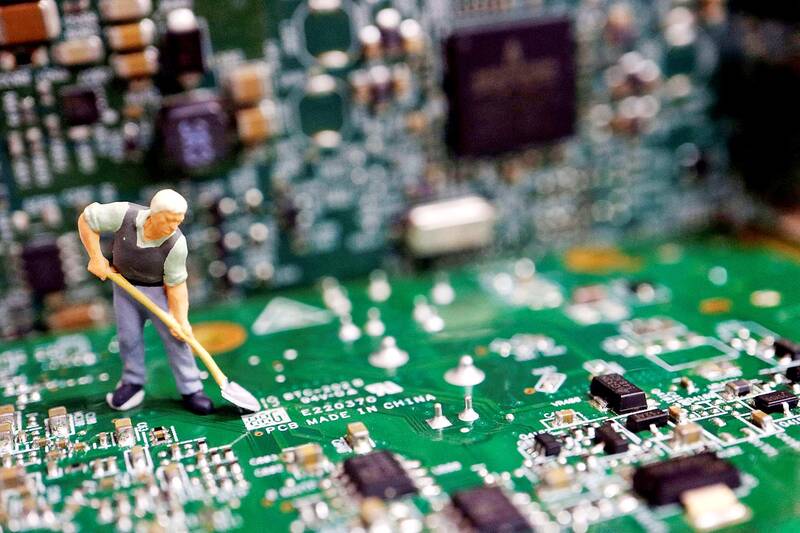US chip production is poised to explode in coming years, helping ease a risky dependency on East Asia, according to a projection by the Semiconductor Industry Association (SIA).
Semiconductor manufacturing capacity in the country will triple by 2032, an SIA-commissioned study by the Boston Consulting Group found. That will take the US share of the industry to 14 percent, up from 10 percent currently, according to the report, which was released yesterday.
The surge will reverse a downward trend for domestic chip production, which had been decamping for Asia in recent decades. Were it not for government funding programs like the 2022 CHIPS and Science Act, the US share was on course to shrink to 8 percent, the study found.

Photo: Reuters
The Washington-based SIA, which lobbied hard for the CHIPS Act, is eager to show that the legislation is paying off. It also wants the US government to devote more funding to the cause.
“We’ve always said that the CHIPS Act was a strong first step, but we’re going to need more to get to the promised land,” SIA chief executive officer John Neuffer said in an interview. “Our industry fully understands that we have an over-concentration of manufacturing in East Asia.”
The CHIPS Act set aside US$39 billion in grants — plus US$75 billion in loans and loan guarantees, and 25 percent tax credits — to persuade semiconductor firms to build factories on American soil.
In the wake of that legislation, the US has secured commitments from all five of the world’s top chipmakers to add facilities in the country. That includes the three main manufacturers of cutting-edge logic chips, the components that serve as the brains of devices: Taiwan Semiconductor Manufacturing Co (台積電), Samsung Electronics Co and Intel Corp.
US Secretary of Commerce Gina Raimondo, whose agency is responsible for doling out CHIPS Act funds, has said the US aims to produce one-fifth of the world’s advanced logic chips by the end of the decade.
Building some extra capacity also will help protect against the kind of disruptions that occurred during the COVID-19 pandemic, Neuffer said. But that represents a shift away from the industry valuing efficiency above all else.
The US isn’t the only one increasing its chip manufacturing ambitions, according to the report. China is building about 30 new facilities for parts of the chip supply chain, topping the US’s 26. And there are eight such projects under way in the European Union.

Nvidia Corp CEO Jensen Huang (黃仁勳) is expected to miss the inauguration of US president-elect Donald Trump on Monday, bucking a trend among high-profile US technology leaders. Huang is visiting East Asia this week, as he typically does around the time of the Lunar New Year, a person familiar with the situation said. He has never previously attended a US presidential inauguration, said the person, who asked not to be identified, because the plans have not been announced. That makes Nvidia an exception among the most valuable technology companies, most of which are sending cofounders or CEOs to the event. That includes

TARIFF TRADE-OFF: Machinery exports to China dropped after Beijing ended its tariff reductions in June, while potential new tariffs fueled ‘front-loaded’ orders to the US The nation’s machinery exports to the US amounted to US$7.19 billion last year, surpassing the US$6.86 billion to China to become the largest export destination for the local machinery industry, the Taiwan Association of Machinery Industry (TAMI, 台灣機械公會) said in a report on Jan. 10. It came as some manufacturers brought forward or “front-loaded” US-bound shipments as required by customers ahead of potential tariffs imposed by the new US administration, the association said. During his campaign, US president-elect Donald Trump threatened tariffs of as high as 60 percent on Chinese goods and 10 percent to 20 percent on imports from other countries.

Taiwanese manufacturers have a chance to play a key role in the humanoid robot supply chain, Tongtai Machine and Tool Co (東台精機) chairman Yen Jui-hsiung (嚴瑞雄) said yesterday. That is because Taiwanese companies are capable of making key parts needed for humanoid robots to move, such as harmonic drives and planetary gearboxes, Yen said. This ability to produce these key elements could help Taiwanese manufacturers “become part of the US supply chain,” he added. Yen made the remarks a day after Nvidia Corp cofounder and chief executive officer Jensen Huang (黃仁勳) said his company and Taiwan Semiconductor Manufacturing Co (TSMC, 台積電) are jointly

United Microelectronics Corp (UMC, 聯電) expects its addressable market to grow by a low single-digit percentage this year, lower than the overall foundry industry’s 15 percent expansion and the global semiconductor industry’s 10 percent growth, the contract chipmaker said yesterday after reporting the worst profit in four-and-a-half years in the fourth quarter of last year. Growth would be fueled by demand for artificial intelligence (AI) servers, a moderate recovery in consumer electronics and an increase in semiconductor content, UMC said. “UMC’s goal is to outgrow our addressable market while maintaining our structural profitability,” UMC copresident Jason Wang (王石) told an online earnings